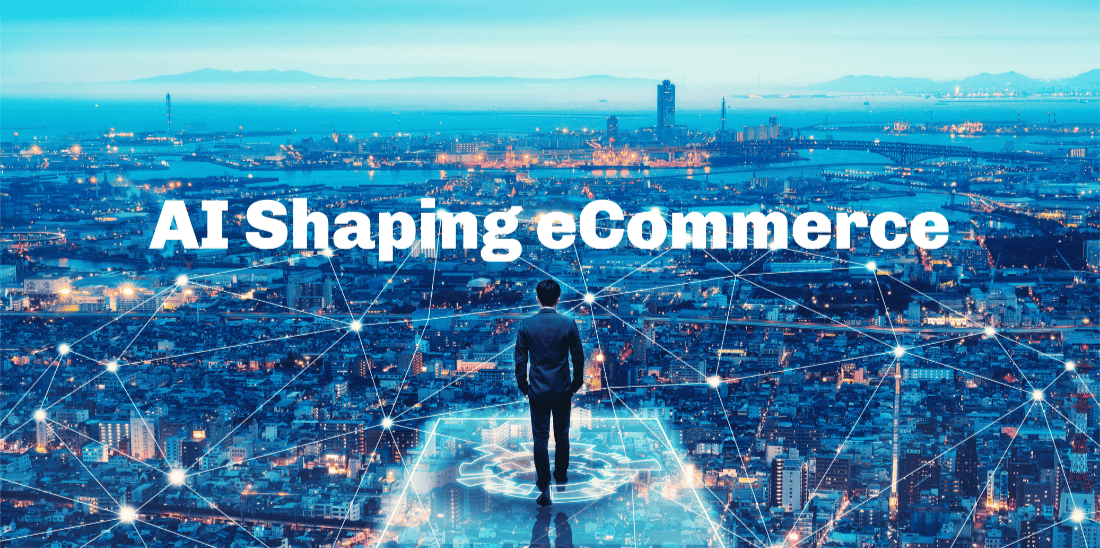List of contents
Discover the AI powered personalisation tool
See a DemoHow to Solve the 10 Things Broken with eCommerce
Download GuideEcommerce product discovery: The AI story so far
List of contents
At the moment, AI is a pretty hot topic. Everywhere you look, there’s a new conversation about how to use it, its effect on industries, or new AI-based product launches. Since ChatGPT came on the scene, it seems AI is all we can talk about (me included!).
But AI isn’t new. In fact, we’ve been using AI within products and services for years. It’s the basis for advertising and recommendations (by companies like Twitter, Facebook, and Netflix since 2006), predictive text, chatbots… And these are just relatively new introductions of AI in the grand scheme of things.
Ecommerce, in particular, has greatly benefited from these recent advancements in technology. AI supports improved customer service, recommendation engines, and the product discovery journey – just to name a few functions. But, not all AI tools currently on the market are bringing results that benefit both the retailer and the customer.
User experience (UX) in the product discovery journey is critical, as this builds trust and longstanding relationships with customers and prospects alike. However, in possibly as little as a few years, the customer journey we’re currently familiar with will change all over again.
The shoppers’ experience
Personally, I don’t think the AI trend has peaked yet – there’s still some really exciting developments still to come. Look at experiential marketing and how that changed the game for retailers, and even this has experienced a huge shift in recent years. Retailers now need to consider what they can offer the online shopper, as opposed to only those that come across their stand outside a major train station or in a city centre.
Think about how we used to make purchases when online shopping first came to fruition. Then, we witnessed a dramatic increase in the amount of purchases made online. And now? Customers expect so much more when buying online.
Experiential marketing isn’t dead, but certainly undergoing a transformation. It’s going to play a big part in connecting product discovery with social media, websites, apps, emails, and even games.
You can already see the start of it with product discovery in ChatGPT and virtual retail stores in Roblox. Retail stores in Roblox aren’t currently using AI, but Roblox users are benefitting from AI-powered search to help find what they need in the Creator Marketplace. By improving their search function, they’re also increasing user engagement. This, in turn, can indirectly support monetisation as users are more likely to spend their time searching and make purchases across the Roblox ecosystem. I’d be willing to put good money on Roblox pioneering the future for UX in ecommerce, if anyone fancies a wager.
While AI could just be the current trend, the changes it has already made to the entire customer journey are hard to deny.
The customer journey & AI
Typically, AI is used in ecommerce to drive revenue, conversions, or operational efficiency. This could be in the form of recommendations for users on product detail pages (PDPs), cross-sells on the checkout page, abandoned cart reengagement, or even enhanced search on your website.
When these tools are marketed to us, they tend to hyperfocus on the narrative of “increase your conversions/revenues/average order value (AOV)”. This is all great but, to be honest, probably a bit short sighted. Anything that claims it will double or triple your revenue overnight by just connecting their solution sounds too good to be true. And it is.
While AI does support increasing revenue and conversions, in actual fact its primary purpose is to improve the user experience and end-to-end product discovery journey. The commitment to iteratively improving that journey is what brings you that revenue growth. It’s a long-term strategy that requires a blend of patience and carefully planned incremental changes – that don’t always have to involve AI.
Personalisation in ecommerce
Personalisation is a big part of the user experience. It shows customers that you understand their wants and needs. Possibly even better than they do. But what used to work for customers just isn’t cutting it anymore. Product recommendations don’t always relate to the customer’s preferences, instead prioritising what the retailer wants to push.
The use of AI to create personalisation in ecommerce seems to be in every tool out there. Of course, different tools use different levels of AI, so you really need to dig deep under the covers to understand exactly what they’re offering.
Users want to find exactly what it is they’re looking for, quickly. But more than that, customers nowadays expect more from the buying experience. If a retailer can’t offer the product they want, nor can they make this product easy to find, they’re likely to lose the sale. Even a single click on your website can tell you a lot about a user and their preferences – so why isn’t this being used to improve UX?
For example, I’m not a white trainers kind of person. No idea why, they’re just not my thing. I’ve never purchased a pair of white trainers. But Reebok keeps sending me emails showing me white trainers. If their tools were performing their promised function, I wouldn’t be receiving these adverts.
Now, let’s look at Amazon as a leading example. Amazon uses filtering techniques combined with extensive data analysis, using factors such as purchasing history and browsing behaviour (and reportedly 35% of their revenue comes from this recommendation engine!). This gives customers a completely personalised homepage, offering a dashboard of products they’ll likely be interested in buying. Their system certainly wasn’t built, or perfected, in a day, but has received regular, iterative updates to offer us the level of recommendations we experience today. Plus, the figures show that Amazon has cracked personalisation amongst their shoppers.
Understandably, not all ecommerce companies have access to the same volume of tools and resources that Amazon does. And what works for Amazon won’t necessarily work for every type of ecommerce store. Nor will their AI model fit with your business model.
Their scale and volume of data is no match for the vast majority of ecommerce stores. At the same time, they are a market place. Market places need a different treatment. So there is never a one size fits all solution.
Which leads me to the problem: personalisation in ecommerce is currently disconnected from the customer journey, and tackled with a myopic point of view. There are a lot of variables, like volume of users, monthly active users, percentage of returning customers… These all affect what AI tool you need to implement to bring positive change.
A fragmented journey
Most recommendation systems out there seem to ground their recs using predominantly views and order based data – which is fine, and can achieve good results. My personal feeling is that it doesn't lead to the best long term outcome for the ecommerce store. So, while you might see revenue going up as more of your best sellers/most popular are being sold, you’re still left with a lot of products that are just taking up storage space (usually your long tail products), need to be discounted in order to be sold, or are distracting from newer, seasonal products that should be taking priority.
This disconnect is even more emphasised when you bring merchandising into the mix. You’re then giving priority to the products that you want to sell – whether they’re relevant to the consumer or not. There’s surely a better way to connect all these touchpoints in the customer journey, to offer real personalisation, whilst still considering business goals and the user experience.
Ecommerce will change and attention spans aren’t getting longer, but experience is going to drive a lot of the change. My personal view is, more interactive shopping experiences are coming. Maybe we should take a leaf out of Roblox’s book, as they certainly seem to be paving the way for the future.








.png)








